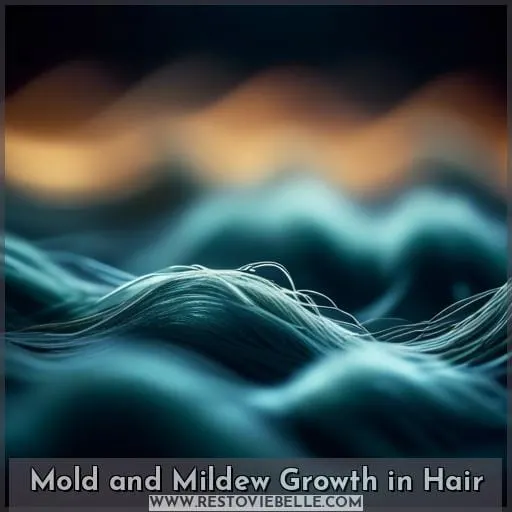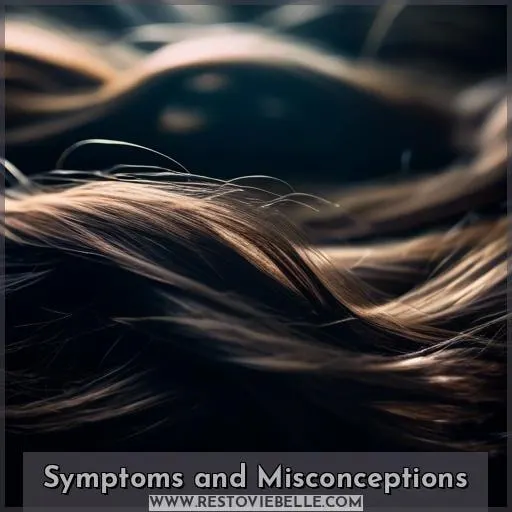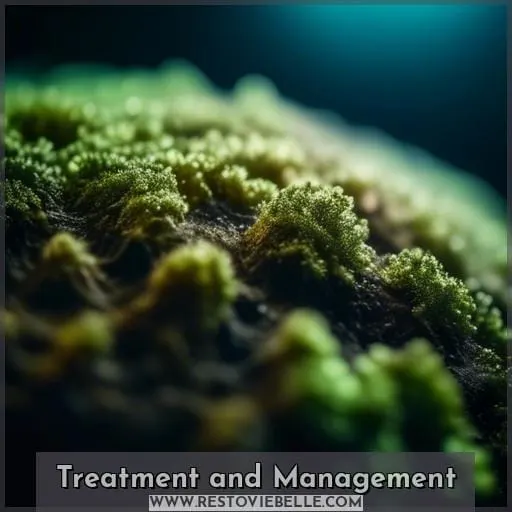This site is supported by our readers. We may earn a commission, at no cost to you, if you purchase through links.
 Imagine stepping out of the shower, your hair damp and your mind at ease, only to find that the very sanctuary of your scalp could harbor unwelcome guests.
Imagine stepping out of the shower, your hair damp and your mind at ease, only to find that the very sanctuary of your scalp could harbor unwelcome guests.
Can your hair get moldy? While the thought might send shivers down your spine, it’s crucial to distinguish between myth and medical reality. Mold, per se, does not grow on human hair, but the scalp can indeed become a breeding ground for various types of fungi, including yeast, that thrive in moist environments.
These fungal invaders, such as Tinea capitis or seborrheic dermatitis, can lead to symptoms mistaken for mold growth, including hair loss, dandruff, and an unpleasant odor. Understanding the conditions that promote fungal growth, recognizing the symptoms, and adopting proper hair care routines are your first steps toward maintaining a healthy scalp.
Let’s delve into the science of hair and fungal infections, debunk misconceptions, and explore effective prevention and treatment strategies.
Yes, while it’s uncommon, your hair can harbor mold if it remains damp for extended periods without proper airflow, creating an environment for mold and mildew to grow. However, there’s no scientific evidence that mold grows on human hair itself, but fungi such as yeast can grow on the scalp and lead to conditions like dandruff or hair loss.
Table Of Contents
- Key Takeaways
- Mold and Mildew Growth in Hair
- Symptoms and Misconceptions
- The Science of Hair and Fungal Infections
- Prevention and Hair Care
- Treatment and Management
- Frequently Asked Questions (FAQs)
- Can wearing hats or head coverings contribute to the development of mold or mildew in hair?
- Are certain hair types or textures more susceptible to mold and mildew growth than others?
- How does the use of hair products like gels, creams, or oils affect the likelihood of developing mold or mildew in hair?
- Can environmental factors other than humidity, such as pollution or exposure to certain chemicals, increase the risk of hair mold or mildew?
- Is it possible for mold or mildew to be transmitted from one person’s hair to another’s, such as through shared hairbrushes or headrests?
- Conclusion
Key Takeaways
- Fungi, including mold and mildew, can grow on the scalp and hair, especially in warm, moist environments, and can lead to symptoms like hair loss, dandruff, and odor.
- Conditions such as seborrheic dermatitis and tinea capitis are fungal infections of the scalp that can occur, and pH imbalances, excess scalp oils, and a weak immune system can increase susceptibility to these infections.
- Mold growth in hair can be identified by symptoms such as redness, scaly patches, swelling, warmth around the infection, pain, scalp lesions, or blisters, and can be accompanied by a musty smell.
- Preventing mold in hair involves keeping the scalp dry and clean, using antifungal shampoos, avoiding tight hairstyles that retain moisture, and ensuring hair is thoroughly dried after washing.
Mold and Mildew Growth in Hair
You might wonder if your hair can become a breeding ground for mold and mildew, especially if you often find yourself with damp locks. Indeed, fungi, including various types of yeast, can thrive in the warm, moist environment your scalp provides if not properly ventilated and dried.
While true mold growth on human hair is a myth, conditions like seborrheic dermatitis and fungal infections such as tinea capitis can occur, leading to symptoms like dandruff, hair loss, and scalp odor.
It’s essential to keep your scalp dry and clean to prevent these fungal conditions.
Conditions That Promote Fungal Growth
Your scalp is like a garden for fungi, thriving when conditions are just right. Think warm, cozy, and a bit on the damp side—like a steamy jungle.
If your scalp’s pH skews, or if those natural scalp oils are out of whack, it’s like rolling out the red carpet for these uninvited guests. Toss in some tight skin folds or a nick from your last DIY haircut, and it’s party time for fungi.
And let’s not forget, your immune health is the bouncer at this shindig. If it’s snoozing on the job, fungi can slip past the velvet rope and cause trouble.
The Role of Moisture and Lack of Ventilation
When it comes to your hair, moisture and poor ventilation can be a recipe for disaster, or in this case, a fungal fiesta.
- Hygiene is key: Just like skipping showers can lead to body odor, neglecting your scalp can invite unwanted fungal guests.
- Habits matter: That cozy, post-shower bun? It might be a snug harbor for scalp fungi, especially if you’re a fan of the ‘wet-and-go’ look.
- Weather woes: High humidity is like a party invitation for mold and mildew, turning your hair into their personal dance floor.
- Accessory alert: Tight hats and headgear can trap moisture, creating a steam room effect right on your noggin.
- pH problems: An unbalanced scalp pH can throw open the doors for fungi, turning your head into their own personal condo.
Symptoms and Misconceptions
When it comes to your scalp, distinguishing between fungal infections and other conditions can be tricky. Common signs of fungal presence, such as itchy, scaly patches or brittle hair, are often misidentified as mere dandruff or dry skin.
It’s crucial to recognize these symptoms early and consult a dermatologist for an accurate diagnosis, as untreated fungal infections can lead to more severe issues, including permanent hair loss.
Common Signs of Fungal Presence in Hair
As we’ve uncovered, your luscious locks can indeed fall victim to fungal foes, leading to a less-than-desirable itchy scalp and other symptoms. If you’re scratching your head, not just in confusion but due to itchiness, you might be hosting a fungal party up there.
Dandruff flakes might be the confetti, and hair breakage the unfortunate party favors. Scalp irritation and redness could be the unwelcome gatecrashers. But don’t fret; it’s not all doom and gloom for your dome.
| Symptom | Fungal Infection | Other Possible Causes |
|---|---|---|
| Itchy Scalp | ️ | Dandruff, Dry Skin |
| Dandruff Flakes | ️ | Psoriasis, Eczema |
| Hair Breakage | ️ | Heat Damage, Chemicals |
| Scalp Irritation | ️ | Allergic Reactions |
| Redness | ️ | Contact Dermatitis |
Misidentification of Scalp Conditions
After spotting those telltale signs of fungal presence in your hair, it’s easy to jump to conclusions.
- Skin conditions are like snowflakes: No two are exactly alike, but they sure can look similar. Psoriasis, seborrheic dermatitis, and fungal infections often share a stage, causing confusion.
- Hair porosity plays a sneaky role: High porosity hair might just be tricking you into thinking there’s a fungal fiesta on your scalp when it’s just thirsty for moisture.
- Home remedies can be double-edged swords: While reaching for that tea tree oil seems like a no-brainer, it’s not a one-size-fits-all. What works for one mightn’t work for another, leading to misinterpretation of effectiveness.
Before you declare a mold emergency, remember that a differential diagnosis from a professional is your best bet. Don’t let Dr. Google lead you astray; medical advice tailored to your unique mane is the way to go.
The Science of Hair and Fungal Infections
When considering the health of your scalp and hair, it’s crucial to understand the unique structure of hair and how it differs from other materials that might be more prone to mold growth.
Your hair, while resilient, can indeed become a breeding ground for certain types of fungi, particularly in warm, moist environments.
This discussion will explore the structural aspects of hair that influence its susceptibility to fungal infections and highlight the specific fungi that are more likely to affect the scalp.
Structural Differences Between Hair and Other Mold-prone Materials
Your hair is a fortress, with a cuticle structure that acts like a shield, warding off unwanted fungal invaders. Unlike bread or fruit that surrender to mold at the first sign of dampness, your hair’s chemical composition and the environment of the hair follicle create a less hospitable zone for fungi.
But, just like a fortress can be breached, so can your hair’s defenses, especially when moisture lingers and ventilation is scarce.
| Hair | Bread | Fruit |
|---|---|---|
| Tough cuticle armor | Soft, porous surface | Delicate, edible skin |
| Keratin-rich with antifungal properties | Easily colonized by spores | Quick to spoil in moisture |
| Hair follicle environment less inviting | No defense once mold takes hold | Mold thrives in nooks and crannies |
Types of Fungi More Likely to Affect the Scalp
When it comes to the fungi that like to party on your scalp, you’re looking at a few uninvited guests.
First up, Tinea capitis, also known as ringworm of the scalp, doesn’t bring worms to the bash but sure knows how to crash it with itchy, scaly patches.
Then there’s Fungal dandruff, caused by a yeast-like fungus called Malassezia, which feeds on the oils on your scalp, making you want to scratch your head in more ways than one.
Folliculitis barbae jumps in, especially if you’re into shaving, leading to itchy and sometimes tender eruptions.
Don’t forget Piedra, which sounds exotic but leaves you with hard nodules on your hair shafts.
And lastly, Scalp yeast infections caused by Candida can turn your scalp into a flaky, itchy mess.
So, keep your scalp’s guest list tight to avoid these fungal party crashers.
Prevention and Hair Care
To prevent fungal infections and maintain a healthy scalp, it’s crucial to dry your hair thoroughly after washing. Wet hair is more susceptible to damage and can foster the growth of mold and bacteria if left damp, especially overnight.
Incorporating best practices for scalp hygiene, such as using antifungal shampoos like ketoconazole for existing conditions, can also help maintain the health of your hair and scalp.
Importance of Drying Hair Thoroughly
Continuing from the science of hair and fungal infections, it’s crucial to understand that keeping your hair wet for extended periods can be a playground for fungi.
So, here’s the deal: drying your hair thoroughly isn’t just about avoiding the ‘wet dog’ look.
Towel drying with a gentle touch using microfiber towels can be a knight in shining armor for your locks, wicking away moisture without roughing up your hair cuticles.
And if you’re in a pinch, a hair dryer can swoop in to save the day—just remember, cool air drying or blow drying on a low heat setting is your hair’s best friend. Keep it moving to avoid heat damage and think of it as a warm breeze rather than a scorching wind.
Best Practices for Scalp Hygiene
After ensuring your hair is as dry as a bone post-shower, let’s dive into the nitty-gritty of scalp hygiene.
First off, shampoo frequency isn’t a one-size-fits-all; it’s your scalp’s way of saying, Let’s talk.
When it comes to brushing, think of it as tender love and care for your locks. Gentle strokes from the bottom up prevent breakage and spread those natural oils, giving your hair that healthy sheen.
Now, heat styling habits – they’re the frenemies of your hair’s health. Too much heat can leave your hair thirstier than a cactus in the desert, so keep it cool for happier strands.
Don’t let product buildup turn your scalp into a no-man’s land; a regular detox can clear the way for healthier hair.
Lastly, scalp exfoliation might sound like a spa day for your head, but it’s a game-changer in preventing flakiness and promoting growth.
Keep these practices in your hair care toolkit, and you’re on your way to a scalp that’s as healthy as a horse.
Treatment and Management
If you’re grappling with a fungal infection in your hair, it’s crucial to understand that treatment typically involves both prescribed oral antifungal medications and diligent hair and scalp care.
Professional medical interventions, such as antifungal shampoos containing ketoconazole or selenium sulfide, are often recommended to manage the spread of infection and maintain scalp hygiene.
In addition to medical treatments, home remedies like tea tree oil and apple cider vinegar can support scalp health, but they should be used with caution and under professional guidance.
Approaches to Address Fungal Infections in Hair
When you’re battling a fungal invasion on your scalp, think of it as waging war on unwanted guests.
First off, antifungal shampoos are your knights in shining armor, ready to fight off the fungal foes with every wash.
Don’t shy away from topical treatments either; they’re like the archers on the battlefield, targeting the problem right at its root.
If you’re a fan of the home remedy brigade, ingredients like honey might just be the secret weapon you need, wielding their natural antifungal properties like magic spells.
Stick to these strategies, and you’ll send those fungal invaders packing, ensuring your scalp remains a fungus-free zone.
Professional Interventions and Home Remedies
Continuing from our previous chat about fungal infections in your hair, let’s dive into how you can tackle this itchy conundrum.
- Over-the-counter treatments: These are your first line of defense. Antifungal shampoos available at your local pharmacy can be a game-changer.
- Tea tree oil: Nature’s little miracle, this oil is like a Swiss Army knife for scalp issues. Just a few drops can go a long way.
- Vinegar rinses: Your salad dressing can double as a scalp savior. A vinegar rinse can rebalance your scalp’s pH and bid adieu to fungus.
- Coconut oil: Not just for cooking, coconut oil can soothe your scalp and put the kibosh on that pesky fungus.
Frequently Asked Questions (FAQs)
Can wearing hats or head coverings contribute to the development of mold or mildew in hair?
Wearing hats, especially during sweaty workouts, can create a damp playground for fungi.
Keep your scalp dry and your hats fresh; a spritz of Lysol might just be your mane’s knight in shining armor.
Are certain hair types or textures more susceptible to mold and mildew growth than others?
Thick, curly, or coily hair types are more prone to mold and mildew due to trapped moisture, making thorough drying essential.
How does the use of hair products like gels, creams, or oils affect the likelihood of developing mold or mildew in hair?
Using hair products like gels, creams, or oils can up the ante for mold or mildew in your mane. They’re like a buffet for fungi, especially if they’re water-based and lacking in preservatives.
Keep your locks dry and clean to dodge the moldy meet-up.
Can environmental factors other than humidity, such as pollution or exposure to certain chemicals, increase the risk of hair mold or mildew?
Like a city’s smog that dulls the skyline, pollution can cast a veil over your hair’s health.
Protect your locks as you would a treasured garden.
Is it possible for mold or mildew to be transmitted from one person’s hair to another’s, such as through shared hairbrushes or headrests?
Yes, it’s possible for mold or mildew to be transmitted from one person’s hair to another’s through shared items like hairbrushes or headrests.
Especially if these items aren’t cleaned properly and remain damp.
Conclusion
So, while your hair turning into a moldy loaf of bread is more fiction than fact, it’s clear that keeping your scalp dry and clean is no laughing matter.
By understanding the conditions that can lead to fungal growth and adopting proper hair care routines, you can ensure your hair remains mold-free.
Let’s keep those unwelcome guests at bay and your hair in top shape.











